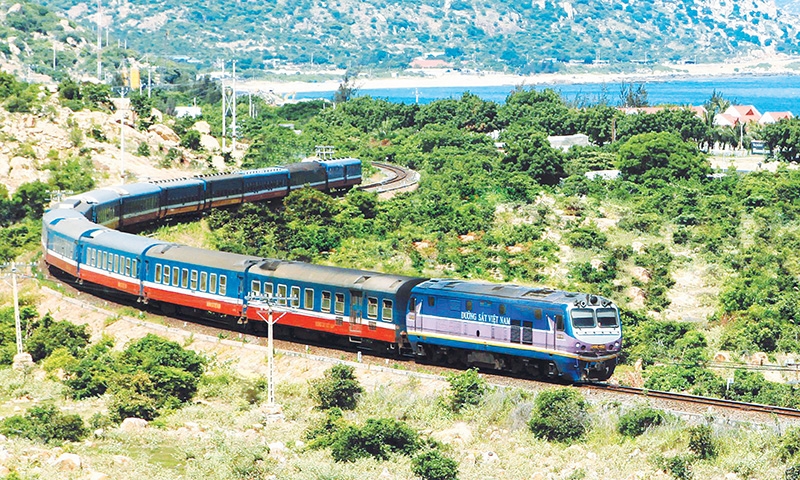Cooperation plans still on hold amid railway system revamp
 |
| Conclusions have still to be made over proposals in regards to railway management and use of assets |
The Commission for the Management of State Capital at Enterprises last week worked with Vietnam Railways (VNR) on separation of some parts in the long-awaited 2021-2025 restructuring plan to be approved first, with the establishment of a passenger transport and cargo transport units being a focus.
Vu Anh Minh, chairman of VNR – the operator of the country’s railway network – told VIR, “We will keep the merger of Haraco and Saratrans, the two largest train operators in Vietnam, under VNR and then proceed with the establishment. The submission of the separation to the prime minister for approval is expected within June.”
VNR expected that it will be able to attract private investment for its development plans when the separation is approved. Thus, in the establishment of a cargo transport company, stakes are being planned to sell for potential investors.
The separation also includes investment in construction of warehouses and inland container depots (ICDs); upgrading and development of railway stations into trade centres and offices for lease in line with the Law on Railways 2017; and upgrading of railway routes connecting with China to develop international railway transportation.
“When the separation and restructuring plan is approved, the new changes will enable the company’s partnership with private firms in hundreds of stations and ICDs to more effectively tap into their available potential, thus enabling us to move faster,” Minh noted.
Industry insiders, however, said that it is impossible that there will be any significant foreign interest in railways, although transport is one of the six sectors covered in the Law on Public-Private Partnership Investment, which took effect from January.
Railways have proven difficult for the public-private partnership (PPP) model in many countries worldwide, with Vietnam being not an exception. More opportunities might come for domestic private firms instead. To enable this, the master scheme in line with implementation of Decree No.46/2018/ND-CP governing the management and use of railway infrastructure assets, should be approved, with VNR’s proposal to hand over 297 railway stations, warehouses, and ICDs to the giant to own, use, and develop with assets to be recorded as state capital contribution to the operator to be included.
However, the master scheme remains at odds with the VNR proposal, and so no final conclusion has yet been made. Legal barriers have so far hindered VNR from making the next steps with its cooperation plans with its partners, and many of its projects as well as investors have been suffering as a result.
In 2017, VNR signed a cooperation agreement with Saigon Newport Corporation to develop ICDs and warehouses at Song Than, Dieu Tri, Yen Vien, Dong Anh, and Dong Dang stations, with the plan to develop more in the future to meet demands. However, the projects have not yet been carried out.
Similarly, Lotte E&C’s proposal to invest in the second phase of the upgrading of the Yen Vien-Lao Cai railway route has been on paper for years, while Japanese auto giant Toyota is seeking to build a railway route connecting its factory in the northern province of Vinh Phuc to the main North-South network, using the Danang railway station as a transhipment hub to other provinces in the central region.
Furthermore, Southern Airports Services JSC has sought a partnership with VNR in upgrading the Saigon Railway Station building. Many other initiatives remain stuck because of Decree 46.
In 2017 when the restructuring plan of VNR was first submitted to authorised agencies, the giant planned for the restructuring by 2020, but inevitable disagreements and legal issues have dragged the proposals into the 2021-2025 period instead.
The separation of the railway network is important at this time as the new restructuring plan is still waiting for completion of a new order that replaces 2017’s Decision No.707/QD-TTg on approving the restructuring of state-owned enterprises. At present, the draft master plan on restructuring of such enterprises for 2021-2025 is still being completed by the Ministry of Finance.
In the last 10 years, the railway sector has failed to mobilise resources for its development plans. State funding for railways, despite an increase, was just $174-196 million annually over the period, which has been mostly used for maintenance works and social security, and not for development plans.
What the stars mean:
★ Poor ★ ★ Promising ★★★ Good ★★★★ Very good ★★★★★ Exceptional
 Tag:
Tag:
Related Contents
Latest News
More News
- Vietnam’s green transition demands collective financial action (December 15, 2025 | 12:00)
- VIR workshop highlights capital and policy for sustainable development (December 15, 2025 | 11:00)
- National Assembly approves pilot mechanisms to accelerate major projects in Hanoi (December 12, 2025 | 11:29)
- Vietnam eases policy approval requirements, simplifies foreign and outbound investments (December 11, 2025 | 17:53)
- Unpacking new momentum in Vietnam’s M&A market (December 10, 2025 | 09:59)
- Forum honours outstanding M&A deals, strategies, and advisory firms (December 09, 2025 | 18:22)
- Vietnam enters defining phase of M&A growth (December 09, 2025 | 17:00)
- Vietnam’s M&A market opens new opportunities amid strong economic momentum (December 09, 2025 | 15:00)
- Vietnam M&A Forum 2025: new position, new momentum (December 09, 2025 | 14:30)
- FDI in Vietnam jumps on additional capital and share purchases (December 09, 2025 | 13:56)
























 Mobile Version
Mobile Version